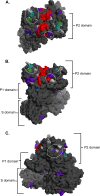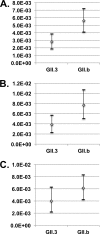The importance of intergenic recombination in norovirus GII.3 evolution
- PMID: 23325692
- PMCID: PMC3624197
- DOI: 10.1128/JVI.03056-12
The importance of intergenic recombination in norovirus GII.3 evolution
Abstract
Norovirus genotype II.3 (GII.3) strains are a major cause of sporadic gastroenteritis. Intergenic recombination between the capsid and RNA-dependent RNA polymerase (RdRp) genes is common and results in the acquisition of an alternative RdRp genotype. This study aimed to explore the evolution of the GII.3 capsid gene, focusing on the influence of intergenic recombination. The capsid genes from six GII.3 norovirus strains, collected from Australian children between 2001 and 2010, were sequenced and aligned with 66 GII.3 capsid sequences from GenBank, spanning 1975 to 2010. The GII.3 capsid gene evolved at a rate of 4.16 × 10(-3) to 6.97 × 10(-3) nucleotide substitutions/site/year from 1975 to 2010 and clustered into five temporally sequential lineages. Clustering of the GII.3 capsid gene sequences was associated with intergenic recombination and switches between RdRp genotypes GII.3, GII.a, GII.b, GII.12, and an undefined ancestral RdRp. Comparison of the substitution rate of the GII.3 and GII.b RdRps suggested that RdRp switching allows a higher evolutionary rate, leading to increased genetic diversity and adaptability. Alignment of GII.3 capsid sequences revealed 36 lineage-specific conserved amino acid substitutions, four of which were under positive selection. Many conserved substitutions were within predicted antibody binding regions and close to host attachment factor binding sites. In conclusion, evolution of GII.3 noroviruses was primarily driven by intergenic recombination. The acquisition of new RdRps may lead to a faster mutation rate and increased genetic diversity, improving overall GII.3 fitness.
Figures




Similar articles
-
Characterization of norovirus strains in Australian children from 2006 to 2008: prevalence of recombinant strains.J Med Virol. 2011 Dec;83(12):2213-9. doi: 10.1002/jmv.22215. J Med Virol. 2011. PMID: 22012731
-
Genetic diversity and epidemiology of Genogroup II noroviruses in children with acute sporadic gastroenteritis in Shanghai, China, 2012-2017.BMC Infect Dis. 2019 Aug 22;19(1):736. doi: 10.1186/s12879-019-4360-1. BMC Infect Dis. 2019. PMID: 31438883 Free PMC article.
-
Comparative evolution of GII.3 and GII.4 norovirus over a 31-year period.J Virol. 2011 Sep;85(17):8656-66. doi: 10.1128/JVI.00472-11. Epub 2011 Jun 29. J Virol. 2011. PMID: 21715504 Free PMC article.
-
Genetic analysis of the capsid gene of genotype GII.2 noroviruses.J Virol. 2008 Aug;82(15):7336-45. doi: 10.1128/JVI.02371-07. Epub 2008 May 14. J Virol. 2008. PMID: 18480447 Free PMC article.
-
The resurgence of the norovirus GII.4 variant associated with sporadic gastroenteritis in the post-GII.17 period in South China, 2015 to 2017.BMC Infect Dis. 2019 Aug 6;19(1):696. doi: 10.1186/s12879-019-4331-6. BMC Infect Dis. 2019. PMID: 31387542 Free PMC article.
Cited by
-
Association between norovirus and rotavirus infection and histo-blood group antigen types in Vietnamese children.J Clin Microbiol. 2014 May;52(5):1366-74. doi: 10.1128/JCM.02927-13. Epub 2014 Feb 12. J Clin Microbiol. 2014. PMID: 24523471 Free PMC article.
-
Noroviruses: Evolutionary Dynamics, Epidemiology, Pathogenesis, and Vaccine Advances-A Comprehensive Review.Vaccines (Basel). 2024 May 29;12(6):590. doi: 10.3390/vaccines12060590. Vaccines (Basel). 2024. PMID: 38932319 Free PMC article. Review.
-
Caliciviruses in hospitalized children, São Luís, Maranhão, 1997-1999: detection of norovirus GII.12.Braz J Microbiol. 2016 Jul-Sep;47(3):724-30. doi: 10.1016/j.bjm.2016.04.008. Epub 2016 Apr 22. Braz J Microbiol. 2016. PMID: 27161199 Free PMC article.
-
An increase in prevalence of recombinant GII.3[P12] norovirus in sporadic acute diarrhea in children in Nizhny Novgorod, Russia, 2018-2021.Virus Genes. 2022 Oct;58(5):467-472. doi: 10.1007/s11262-022-01919-3. Epub 2022 Jun 9. Virus Genes. 2022. PMID: 35680691
-
Predicting Dominant Genotypes in Norovirus Seasons in Japan.Life (Basel). 2023 Jul 27;13(8):1634. doi: 10.3390/life13081634. Life (Basel). 2023. PMID: 37629491 Free PMC article.
References
-
- Bresee JS, Marcus R, Venezia RA, Keene WE, Morse D, Thanassi M, Brunett P, Bulens S, Beard RS, Dauphin LA, Slutsker L, Bopp C, Eberhard M, Hall A, Vinje J, Monroe SS, Glass RI. 2012. The etiology of severe acute gastroenteritis among adults visiting emergency departments in the United States. J. Infect. Dis. 205:1374–1381 - PubMed
-
- Xi JN, Graham DY, Wang KN, Estes MK. 1990. Norwalk virus genome cloning and characterization. Science 250:1580–1583 - PubMed
-
- Green KY, Ando T, Balayan MS, Berke T, Clarke IN, Estes MK, Matson DO, Nakata S, Neill JD, Studdert MJ, Thiel HJ. 2000. Taxonomy of the caliciviruses. J. Infect. Dis. 181(Suppl. 2):S322–S330 - PubMed
Publication types
MeSH terms
Substances
Grants and funding
LinkOut - more resources
Full Text Sources
Other Literature Sources
Medical
Research Materials

